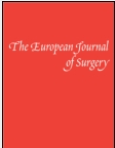Translocation of Salmonella typhimurium in rats; effect of enteral and parenteral nutrition
Abstract
Objective:
To study translocation of Salmonella typhimurium from ileal loops in rats fed enterally or parenterally.
Design:
Laboratory experiment.
Setting:
University departments of surgery and microbiology, Japan.
Subjects:
Male Wistar rats and female BALB/C CrSlc mice.
Interventions:
First experiment: portal venous blood and mesenteric lymph nodes from normally fed rats were cultured under aerobic and anaerobic conditions. Second experiment: various concentrations of S. typhimurium (GIFU 12142) were injected intraperitoneally in mice and their survival was monitored. Third experiment: 7 rats were given total parenteral nutrition for 14 days and 6 were given standard chow and water for the same period. Cultures of S. typhimurium were injected into closed ileal loops and portal and vena caval blood and mesenteric lymph nodes were cultured.
Main outcome measures:
Presence and number of bacteria in all samples, and survival of mice.
Results:
In the first experiment 3/17 blood samples and 9/17 node samples grew enteric bacteria. In the second experiment all the mice died within 5 days. In the third experiment no sample grew bacteria in the enterally fed group, whereas at least some samples from 5/7 rats in the parenterally fed group grew organisms; the difference was significant (p = 0.02).
Conclusion:
Total parenteral nutrition encourages the translocation of S. typhimurium from ileal loops. Copyright © 2000 Taylor and Francis Ltd.




